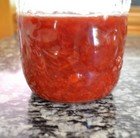Homemade Liquid Pectin Instructions, Testing and Recipe
Wash, core and quarter 1 pound of unpeeled tart apples and slice thinly into a large pot. For each pound of fruit add 2 cups water.
Cover and boil slowly for 15 minutes. Strain through a colander lined with cheesecloth and reserve the juice.
Return the apple pulp back to the pot and add 2 more cups of water. Cook again for 15 minutes, let stand for 10 minutes and then restrain through the cheesecloth. Squeeze well to extract all the juice.
Now mix the two batches of juice together. You should have 1 quart of liquid pectin from your 1 pound of apples. You can either place it in the fridge for when you want to use it later, or if you want to store it for more than a few days then you will need to bring the liquid pectin to the boil, place in hot, sterilized jars and seal.
How to use Liquid Pectin for Jam Making
There is a more accurate way of working out how much liquid pectin you need in jam making, and this is done by using rubbing alcohol or methylated spirits. The instructions of doing this can be found below.
However, if you are looking for a quick fix to making jam with your homemade pectin then here is a simple recipe.
Mix 2 cups homemade pectin with 2 cups fruit pulp and 2 cups sugar. Boil slowly until the mixture reaches 221 degrees F. This is the jellying point of any jam making at sea level.
Testing the Strength of Pectin using Rubbing Alcohol
 If you are not sure whether the fruit you are
working with contains
enough natural pectin or not, then you can try this pectin test. Add 1
teaspoon of any cooked fruit puree or pure juice to 1 tablespoon
running alcohol or methylated spirits.
If you are not sure whether the fruit you are
working with contains
enough natural pectin or not, then you can try this pectin test. Add 1
teaspoon of any cooked fruit puree or pure juice to 1 tablespoon
running alcohol or methylated spirits. Now watch the action between the fruit and the alcohol. If the fruit is rich in pectin it will form a stiff jellied mass, stiff enough to pick up with fork. If it is low in pectin, it will form small, flaky pieces that cannot be picked up as one piece.
If you are still not sure at this stage, you can do some further testing. Add 1 tablespoon liquid pectin to 1 cup cooked fruit puree or juice. Remove 1 teaspoon, combine with 1 tablespoon rubbing alcohol and test again. If it still doesn't jell, add 1 more tablepoon liquid pectin to the cup of fruit. Remove another teaspoon of fruit or juice and test again with another tablespoon of alcohol.
Be sure to throw away your tested samples and don't taste them or allow your children or pets to get hold of them in any way as the alcohol contains a poison.
Once you have determined how many tablespoons of pectin you will need per cup of fruit to get it to gel, then just multiple that by the number of total cups of fruit used. For example, if you to added 3 tablespoon of pectin to your cup of fruit before it would jell in your sampling, then you'll need 9 tablespoons liquid pectin for 3 cups of fruit.






New! Comments
Do you have something of value to add? Leave me a comment in the box below.